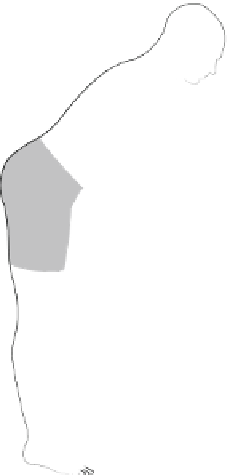Biomedical Engineering Reference
In-Depth Information
a
b
W
2
12°
W
2
F
F
C
W
1
W
1
30°
=
30°
W
2x
F
y
W
2y
60°
W
1x
W
1y
F
x
C
x
30°
C
y
Fig. 6.2
(
a
) An adult lifting a weight from the floor. The spinal column is represented by a
bar
.(
b
)
Simplified geometric model, with all of the applied forces on the column and the distances
involved
0
¼
-
W
1
y
-
W
2
y
-
C
y
+
F
y
; The only unknown is
C
y
¼
86.8 N,
0
¼
-
W
2
x
-
W
1
x
-
F
x
+
C
x
; The only unknown is
C
x
¼
3,380.0 N.
Performing the vector sum:
C
y
2
+
C
x
2
C
2
and extracting the square root, we
¼
obtain:
C
¼
3,381.0 N.
This result informs us that if a person with a weight force of 700 N, which is
reasonable for a person with a trunk weighing 300 N, lifts an object with 200 N
weight incorrectly, the intervertebral disc between the fifth lumbar vertebra and the
sacrum is subject to a compression force somewhat smaller than five times his body
weight; now the angle
α
can be obtained:
1.47
.
sin
α ¼
C
y
/
C
;
α ¼
arc sin 0.026
¼
Exercise 6.5
Repeat example 6.5 considering that the person will lift an object
from the floor weighing 500 N. Determine the magnitudes of muscle force
F
and
that of contact force (reaction)
C
and the direction of
C
.
Now we determine for the same person of Example 6.5 the relation between the
mass of an object that is lifted incorrectly, without bending of the knees and
the intensity of the muscle force,
F,
and that of the contact force,
C
, applying the


















































































































